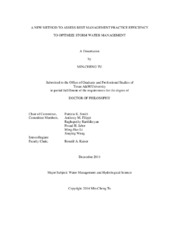| dc.description.abstract | For TSS, TN, and TP, this study examined the relationship between BMP pollutant removal efficiency and environmental factors such as ratio of BMP/catchment area, dominant land use, ratio of the dominant land use/catchment area, slope, and BMP type, and derived optimal installation plans based on different criteria.
A SWMM model was built for the Shoal Creek Watershed in Austin, Texas. Inverse modeling (i.e. fitting model to observation data) was used to calibrate the BMP removal efficiency. The relationship can then be derived by using multiple linear regression analysis with BMP removal efficiency as the response variable and the environmental factors as predictive variables.
However, before inverse modeling can be applied, SWMM pollutant buildup and washoff parameters must be derived. A few types of land use were identified as main source of pollutant. The numerical distribution of the parameters suggested that the buildup and the washoff parameters are controlled by forces of different spatial scales.
Also, the SWMM model simulated only direct runoff in order to simplify the calibration. Mean pollutant concentration in base flow is required to convert observed concentration to that in direct runoff. The Shoal Creek Watershed discharges into Lady Bird Lake, and changes of water quality in the lake during base flow dominant dates were used to estimate concentration in base flow from Shoal Creek Watershed. Water quality of the lake was determined by Landsat imagery.
The equations predicting BMP removal efficiency based on environmental factors were analyzed to show the most efficient and least efficient type of BMP and the land use that BMPs will have the highest and lowest removal efficiency for TSS, TN, and TP.
Two planning criteria were utilized for the optimal BMP plans and different time frames were considered. One criterion is goal concentrations in runoff, and the other is a combination of goal concentration and a budget constraint. For each criterion, the associated optimal plan showed an areal ratio between BMP types throughout different time frame. It was also found that the Shoal Creek Watershed needs more BMPs. Suggestions to the Environmental Criteria Manual of Austin were also made based on this study. | en |


